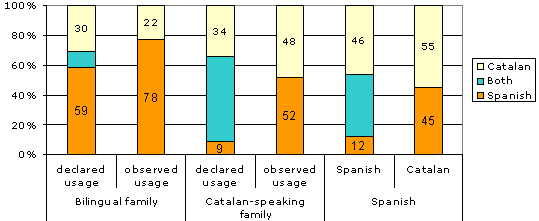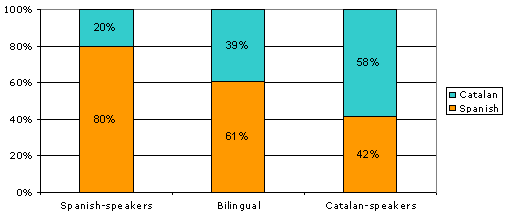
Factors
explaining informal linguistic usage among Catalan schoolchildren:
initial language, social networks, competence and vehicular language
for teaching, by Mireia Galindo i F. Xavier Vila i Moreno |
||||
| CONTINUA |
2.3.
Declared data, observed data: between perception and reality Graph 2. Declared and observed
linguistic choices observed for Soruce: Vila and Galindo body of data As can be seen in graph 2, actual use of Spanish is always higher than the perception. Although only 59% of Spanish speaking children say they normally use Spanish with their friends, in their free time 80% of their speaking turns are produced in Spanish. These figures make it clear that some of the Spanish-speakers who declare themselves to be bilingual in their social networks (11%) and some who say they normally relate to others in Catalan (30%) are, in practice, active users of Spanish. A similar phenomenon occurs with children from Catalan-speaking families and, in a sense, it is perhaps more accentuated: only 12% declare that they actively use Spanish, but 42% of the turns they produce are in Spanish. As in the previous case, declared bilingual usages conceal mainly Spanish linguistic practices. The conclusions that can be drawn from analysing bilingual families follow the lines noted for the other two linguistic groups. We are looking at a phenomenon that has already been observed in other studies (Vila 1996, Rosselló 2003), but which is now clearly and empirically corroborated, as it can be based on the comparison of declared and observed data for a large enough sample of informants and interactions: some children who use little Catalan – sometimes only isolated words – attribute much more weight to this language in their linguistic usages than it actually has; by contrast, children who use Spanish frequently tend to reduce the presence of this language when they are asked to quantify their linguistic practices. In others words, informants over-value the use of Catalan in declared data: a very important piece of information for sociolinguistic research in the Catalan sphere. 3. The factors explaining linguistic choice 3.1. The role of the family language and social networks on the choices observed In accordance with the available data, the language for relationships between members of the home largely determines the language normally used during free time. At school, children from both Catalan-speaking and Spanish-speaking families produce and receive more messages in the language which is predominant at home. However, in this relationship between the family language and the language used at schools, important differences are observed between the two groups: of every 5 turns produced and received by Spanish-speakers, 4 are in Spanish; by contrast, Catalan-speakers only speak and are spoken to in Catalan in 3 out of every 5 turns. The behaviour of bilingual families is close to that of Spanish-speakers: they produce and receive more turns in Spanish (3 out of 5) than in Catalan (graphs 3 and 4).(4) GRAPH 3. Language of speaking turns produced by each linguistic group of families
Source: Vila and Galindo body of data
|
||

